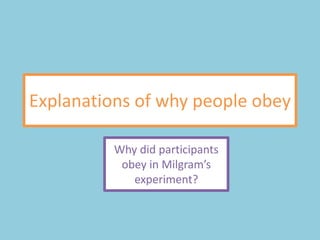
Explanations of obedience
- 1. Explanations of why people obey Why did participants obey in Milgram’s experiment?
- 2. Four reasons why individuals obey authority figures 1. Gradual Commitment 2. Legitimate Authority 3. Agentic Shift 4. Dehumanisation
- 3. Gradual commitment Participants become locked into obedience in small steps ‘Foot in the door’ technique Once you have made some sort of commitment it’s hard to go back on it. Real life example?
- 4. What techniques did you use? ‘Take it for a test ‘Why don’t you sit drive, see how it in the car and see feels’ if you like it?’ ‘Can I just take some details so that ‘Imagine driving we can enter you home in your new into the system?’ car today’
- 5. Gradual Commitment A02 P – Evidence to support the gradual commitment explanation of obedience comes from Milgram’s experiment E – For example, the participant was required to administer shocks starting from 15v and increasing in 15v increments (each action was small making it harder to back out) E – This is a strength because Milgram’s research demonstrates that small level obedience and increasing in small stages make it very difficult for the participant to disobey
- 6. Legitimate Authority The amount of social power held by the person who gives Society is ordered the instruction in a hierarchical way From early childhood we are taught that we should obey those who have authority over us Trust We obey legitimate authority because: Punishment
- 7. Legitimate Authority A02 P – Evidence to support the legitimate authority explanation of obedience comes from Milgram’s experiment E – For example, obedience rates were much higher when the research took place at Yale with the experimenter wearing a lab coat compared to the variation in a run-down office block with the experimenter in ‘normal’ clothes E – This is a strength because it shows that the perceived amount of authority a person holds will directly impact the extent to which others will obey them.
- 8. Form your own hierarchy • Think of who you obey in your life • Place them in the hierarchy template • Now try to decide if you obey because you trust them or fear punishment
- 9. Agentic Shift It’s easy to deny personal responsibility when an order has Individuals become ‘agents’ come from an authority figure for an external authority Obedience occurs because of a conflict between internal and external authority: Internal Authority Own conscience External Authority Authority Figure
- 10. Agentic Shift A02 P – Evidence to support the agentic shift explanation of obedience comes from Milgram’s experiment E – For example, many participants throughout the research expressed concern as to the fact they believed they’d be held responsible for any harm done to the ‘learner’, to which the experimenter replied that they’d take full responsibility E – This supports the idea of the agentic shift as the participants demonstrated that they would obey the authority figure when they considered themselves to be an agent/worker for an external authority
- 11. Dehumanisation We are more likely to inflict harm on someone if we can Role of ‘buffers’ distance ourselves from the - often seen in victim war Remove the persons individuality (e.g. removing face, name) Dehumanisation makes it easier to remove/avoid moral responsibility
- 12. Dehumanisation A02 P – Evidence to support the dehumanisation explanation of obedience comes from Milgram’s experiment E – For example, in the original experiment Mr Wallace (the ‘learner’) was placed in a separate room to the participant, allowing them to distance themselves from the ‘learner’ and their pain, however, in the variations where the ‘learner’ was brought to the same room as the participant obedience rates dropped E – This supports the idea of dehumanisation, whereby people are more willing to inflict harm on others if they can remove themselves from the individual as a ‘real person’ and rather view them as a number
- 13. We know why people conform and obey - Now we need to work out... Why do some people remain independent and resist conformity and obedience? In pairs/threes discuss this and write some answers down on the post-it provided